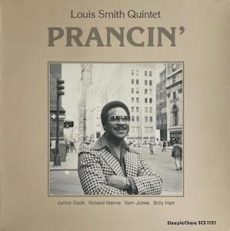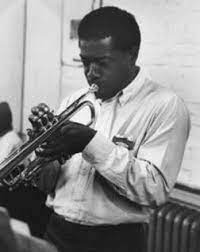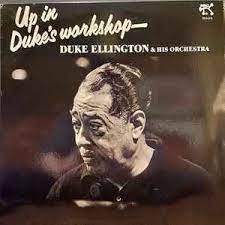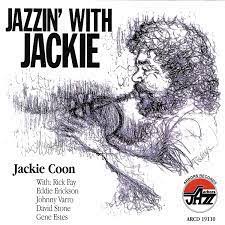
Requisites
Prancin’ ~ Louis Smith Quintet | By Eddie Carter
The Louis Smith Quintet provides this morning’s subject with their 1979 album, Prancin’ (SteepleChase Records SCS 1121). It was Smith’s second release for the label and his fourth as a leader. This session also marks a reunion with Junior Cook, who he played with briefly in The Horace Silver Quintet twenty-one years earlier. Their only recorded appearance together is on Blue Lights, Volumes 1 and 2 by Kenny Burrell. Here, Louis Smith is featured on flugelhorn (tracks: A2, B2) and trumpet (A1, A3, B1, B3), alongside Junior Cook on tenor sax, Roland Hanna on piano, Sam Jones on bass and Billy Hart on drums. My copy is the original Danish Stereo album.
One For Nils, Smith’s first of five originals, is a tune written for producer and label founder Nils Winther. The quintet sets the beat in its opening chorus. Louis gets right to the point first; then Junior comes in with a smooth, relaxed reading. Roland feeds the finale with fresh ideas ahead of the theme’s reprise and exit. Chanson De Louise is Smith’s beautiful tribute to his wife, Harriet Louise. Hanna introduces this ballad softly, leading to a delicately tender theme by Smith and Cook. The leader’s opening solo is affectionate and touching; next, Hanna provides serene beauty to a short statement into the ensemble’s gentle ending.
Ryan’s Groove is dedicated to a friend and fellow teaching colleague and takes off from the quintet’s rousing theme. Junior gets things off to a sizzling start; then Louis slices through the second reading like a hot knife through butter. Roland comes in next, followed by Sam’s brisk bass, leading to the climax. The title tune, Prancin’, starts Side Two with Hanna’s introduction segueing into the group’s lively melody. In the opening solo, Cook immediately gets the listener’s attention; then Smith keeps the temperature up in the following statement. Hanna makes the third solo come alive with a nice, happy feeling. Hart closes with a quick exchange between both horns preceding the finish.
I Can’t Get Started by Vernon Duke and Ira Gershwin is one of the timeless jazz standards. Louis is the only horn, and the rhythm section works in perfect symmetry on the opening chorus. The leader’s flugelhorn brings out the song’s lyrical beauty in a gorgeous interpretation that’s the icing on the cake into a gentle conclusion. Fats is Smith’s tribute to trumpeter Theodore “Fats” Navarro. The album’s closer gets off to a good start with the front line’s introduction and melody. Hanna, Cook, Smith, and Jones give four solos that provide a perfect exclamation point to this enjoyable blowing session.
Nils Winther produced Prancin’, and Elvin Campbell was the recording engineer. The album sounds incredible from start to finish. It has a breathtaking soundstage that brings the musicians to your listening room with exceptional clarity. The record is also a great pressing that’s silent until the music starts. Louis was an equally excellent composer, as the tunes here demonstrate. If you’re in the mood for Hard-Bop and Modal Jazz, I offer Prancin’ by The Louis Smith Quintet for your consideration on your next record shopping trip. It’s a terrific album with tight musicianship that hits it out of the park and is an absolute delight!
~ Blue Lights, Volume 1 (Blue Note BLP 1596/BST 81596), Blue Lights, Volume 2 (Blue Note BLP 1597/BST 81597) – Source: Discogs.com
~ I Can’t Get Started – Source: JazzStandards.com
© 2023 by Edward Thomas Carter
More Posts: choice,classic,collectible,collector,flugelhorn,history,instrumental,jazz,music

CHALIS O’NEAL TRIO
Chalis O’Neal is one of the best trumpet players in Kansas City and we are lucky to have his trio coming to perform. Make your reservation today before tables fill up!
More Posts: adventure,album,club,festival,flugelhorn,genius,jazz,museum,music,preserving,restaurant,travel

Three Wishes
It was Al Shorter that she approached with the question of three wishes and he told Nica he had only one wish that summed it all up:
- “I want to live more than my life. That’s all my three wishes, really.”
More Posts: baroness,flugelhorn,history,instrumental,jazz,music,pannonica,three,trumpet,wishes

Daily Dose Of Jazz…
Fred Stone was born on September 9, 1935 in Toronto, Ontario, Canada and was the son of saxophonist Archie Stone. His initial musical studies were with his father. At the age of 14 he began studying the trumpet with Donald Reinhardt in Philadelphia, Pennsylvania and spent every summer in that city from 1950–1955. At home he studied music theory and music composition with Gordon Delamont and John Weinzweig.
Commencing his performance career in 1951 at the age of 16 he played in Benny Louis’s big band. From 1955 to 1967 he was a trumpeter in various orchestras related to the Canadian Broadcasting Corporation, including the CBC Symphony Orchestra. During the late 1950s and 1960s he performed widely as a concert soloist with orchestras throughout North America. He was an active performer as a jazz musician, playing regularly with Ron Collier , Phil Nimmons , the Boss Brass, and Lighthouse and he toured North America and Europe with the Duke Ellington Orchestra.
Returning to Toronto in 1971, Stone became highly involved with his work as a teacher, and operated his own private studio where he taught improvisational theory and music composition. His performance career virtually ceased for the remainder of the decade, although he remained active as a composer. Between 1971 and 1983 he mainly focused on his work as a composer and teacher, making only periodic public performances, and often with ensembles composed largely of his students.
In 1984 he formed Freddie’s Band, a jazz ensemble in residence at The Music Gallery in Toronto. Flugelhornist, trumpeter, pianist, composer, writer, and music educator Fred Stone recorded eleven albums as a sideman before he transitioned on December 10, 1986.
More Posts: educator,flugelhorn,history,instrumental,jazz,music,trumpet,writer

Daily Dose Of Jazz…
Jackie Coon was born in Beatrice, Nebraska on June 21, 1929 and grew up in Southern California. He was inspired to play trumpet after hearing Louis Armstrong’s West End Blues. He spent a few months with Jack Teagarden’s band and had gigs with Charlie Barnet, Louis Prima, and Earl Hines.
Making his recording debut with Barney Bigard in 1957 and he also played the mellophone on Red Nichols’ version of Battle Hymn of the Republic. Jackie’s decision to stay in California cost him the fame that eluded him, but he worked at Disneyland for nine years, and performed regularly in local clubs and jazz festivals.
It was until 1986 that Coon led his first record session for Sea Breeze. Since 1991 he has recorded fairly often for Arbors. Trumpeter, flügelhornist and cornetist Jackie Coon has become less active in his Eighties.
More Posts: bandleader,cornet,flugelhorn,history,instrumental,jazz,music,trumpet




